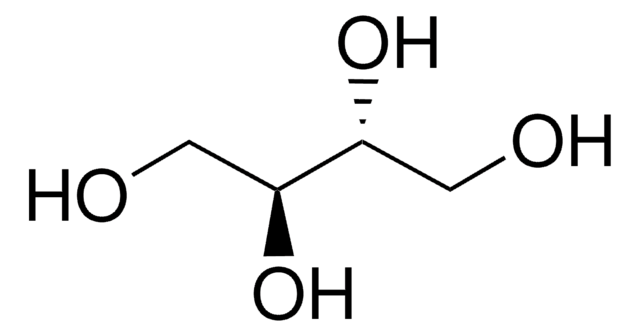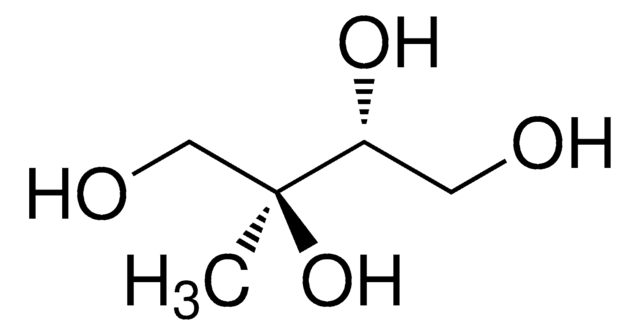推荐产品
等級
pharmaceutical primary standard
API 家族
erythritol
製造商/商標名
EDQM
bp
329-331 °C (lit.)
mp
118-120 °C (lit.)
應用
cleaning products
cosmetics
food and beverages
personal care
pharmaceutical (small molecule)
格式
neat
儲存溫度
2-8°C
SMILES 字串
OC[C@@H](O)[C@@H](O)CO
InChI
1S/C4H10O4/c5-1-3(7)4(8)2-6/h3-8H,1-2H2/t3-,4+
InChI 密鑰
UNXHWFMMPAWVPI-ZXZARUISSA-N
正在寻找类似产品? 访问 产品对比指南
相关类别
一般說明
This product is provided as delivered and specified by the issuing Pharmacopoeia. All information provided in support of this product, including SDS and any product information leaflets have been developed and issued under the Authority of the issuing Pharmacopoeia.For further information and support please go to the website of the issuing Pharmacopoeia.
應用
Erythritol EP Reference standard, intended for use in laboratory tests only as specifically prescribed in the European Pharmacopoeia.
生化/生理作用
Tas1r3 基因的等位变异影响对该糖醇的行为味道反应,表明它是T1R3 受体配体。
包裝
The product is delivered as supplied by the issuing Pharmacopoeia. For the current unit quantity, please visit the EDQM reference substance catalogue.
其他說明
Sales restrictions may apply.
儲存類別代碼
11 - Combustible Solids
水污染物質分類(WGK)
WGK 1
閃點(°F)
Not applicable
閃點(°C)
Not applicable
其他客户在看
Yong-Cheol Park et al.
Journal of chromatography. B, Analytical technologies in the biomedical and life sciences, 815(1-2), 251-260 (2005-01-18)
In-depth knowledge bases on physiological properties of microbes are required to design a better microbial system at a gene level and to develop an industrially viable process in an optimized scheme. Proteomic analyses of industrially useful microorganisms are particularly important
M Wanke et al.
Acta biochimica Polonica, 48(3), 663-672 (2002-02-09)
Higher plants, several algae, bacteria, some strains of Streptomyces and possibly malaria parasite Plasmodium falciparum contain the novel, plastidic DOXP/MEP pathway for isoprenoid biosynthesis. This pathway, alternative with respect to the classical mevalonate pathway, starts with condensation of pyruvate and
Deepak Ganjewala et al.
Current issues in molecular biology, 11 Suppl 1, i35-i45 (2009-02-06)
Isoprenoids, also known as terpenoids, are biosynthesized by the condensation of the two C5 unit isopentenyl diphosphate (IPP) and isomer dimethylallyl diphosphate (DMAPP). Generally, plants use two separate pathways plastidial Methyl-erythritol-4-phosphate (MEP) and cytosolic acetate-mevalonate (MVA) pathways for formation of
Erythritol: a novel noncaloric sweetener ingredient.
P de Cock
World review of nutrition and dietetics, 85, 110-116 (2000-01-27)
A Banerjee et al.
Natural product reports, 31(8), 1043-1055 (2014-06-13)
Covering: up to February 2014. The methylerythritol 4-phosphate (MEP) pathway is the recently discovered source of isoprenoid precursors isopentenyl diphosphate (IDP) and dimethylallyl diphosphate (DMADP) in most bacteria, some eukaryotic parasites, and the plastids of plant cells. The precursors lead
我们的科学家团队拥有各种研究领域经验,包括生命科学、材料科学、化学合成、色谱、分析及许多其他领域.
联系技术服务部门









